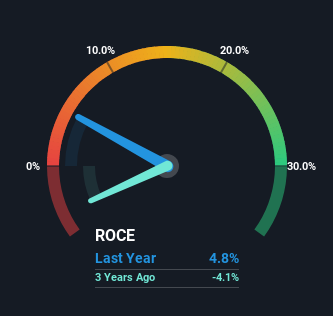- South Korea
- /
- Semiconductors
- /
- KOSDAQ:A122640
YEST's (KOSDAQ:122640) Returns On Capital Are Heading Higher
If we want to find a stock that could multiply over the long term, what are the underlying trends we should look for? One common approach is to try and find a company with returns on capital employed (ROCE) that are increasing, in conjunction with a growing amount of capital employed. If you see this, it typically means it's a company with a great business model and plenty of profitable reinvestment opportunities. Speaking of which, we noticed some great changes in YEST's (KOSDAQ:122640) returns on capital, so let's have a look.
Return On Capital Employed (ROCE): What Is It?
If you haven't worked with ROCE before, it measures the 'return' (pre-tax profit) a company generates from capital employed in its business. To calculate this metric for YEST, this is the formula:
Return on Capital Employed = Earnings Before Interest and Tax (EBIT) ÷ (Total Assets - Current Liabilities)
0.048 = ₩6.8b ÷ (₩201b - ₩60b) (Based on the trailing twelve months to June 2024).
Thus, YEST has an ROCE of 4.8%. On its own that's a low return on capital but it's in line with the industry's average returns of 5.4%.
See our latest analysis for YEST

Historical performance is a great place to start when researching a stock so above you can see the gauge for YEST's ROCE against it's prior returns. If you're interested in investigating YEST's past further, check out this free graph covering YEST's past earnings, revenue and cash flow.
How Are Returns Trending?
Shareholders will be relieved that YEST has broken into profitability. While the business was unprofitable in the past, it's now turned things around and is earning 4.8% on its capital. While returns have increased, the amount of capital employed by YEST has remained flat over the period. That being said, while an increase in efficiency is no doubt appealing, it'd be helpful to know if the company does have any investment plans going forward. After all, a company can only become a long term multi-bagger if it continually reinvests in itself at high rates of return.
The Key Takeaway
In summary, we're delighted to see that YEST has been able to increase efficiencies and earn higher rates of return on the same amount of capital. Considering the stock has delivered 35% to its stockholders over the last five years, it may be fair to think that investors aren't fully aware of the promising trends yet. Given that, we'd look further into this stock in case it has more traits that could make it multiply in the long term.
If you'd like to know more about YEST, we've spotted 2 warning signs, and 1 of them can't be ignored.
If you want to search for solid companies with great earnings, check out this free list of companies with good balance sheets and impressive returns on equity.
New: Manage All Your Stock Portfolios in One Place
We've created the ultimate portfolio companion for stock investors, and it's free.
• Connect an unlimited number of Portfolios and see your total in one currency
• Be alerted to new Warning Signs or Risks via email or mobile
• Track the Fair Value of your stocks
Have feedback on this article? Concerned about the content? Get in touch with us directly. Alternatively, email editorial-team (at) simplywallst.com.
This article by Simply Wall St is general in nature. We provide commentary based on historical data and analyst forecasts only using an unbiased methodology and our articles are not intended to be financial advice. It does not constitute a recommendation to buy or sell any stock, and does not take account of your objectives, or your financial situation. We aim to bring you long-term focused analysis driven by fundamental data. Note that our analysis may not factor in the latest price-sensitive company announcements or qualitative material. Simply Wall St has no position in any stocks mentioned.
About KOSDAQ:A122640
YEST
Engages in the manufacture and sale of semiconductors and display manufacturing equipment in Korea and internationally.
Excellent balance sheet and slightly overvalued.
Market Insights
Community Narratives


Recently Updated Narratives


MINISO's fair value is projected at 26.69 with an anticipated PE ratio shift of 20x


The Quiet Giant That Became AI’s Power Grid


Nova Ljubljanska Banka d.d will expect a 11.2% revenue boost driving future growth
Popular Narratives


The company that turned a verb into a global necessity and basically runs the modern internet, digital ads, smartphones, maps, and AI.


MicroVision will explode future revenue by 380.37% with a vision towards success



